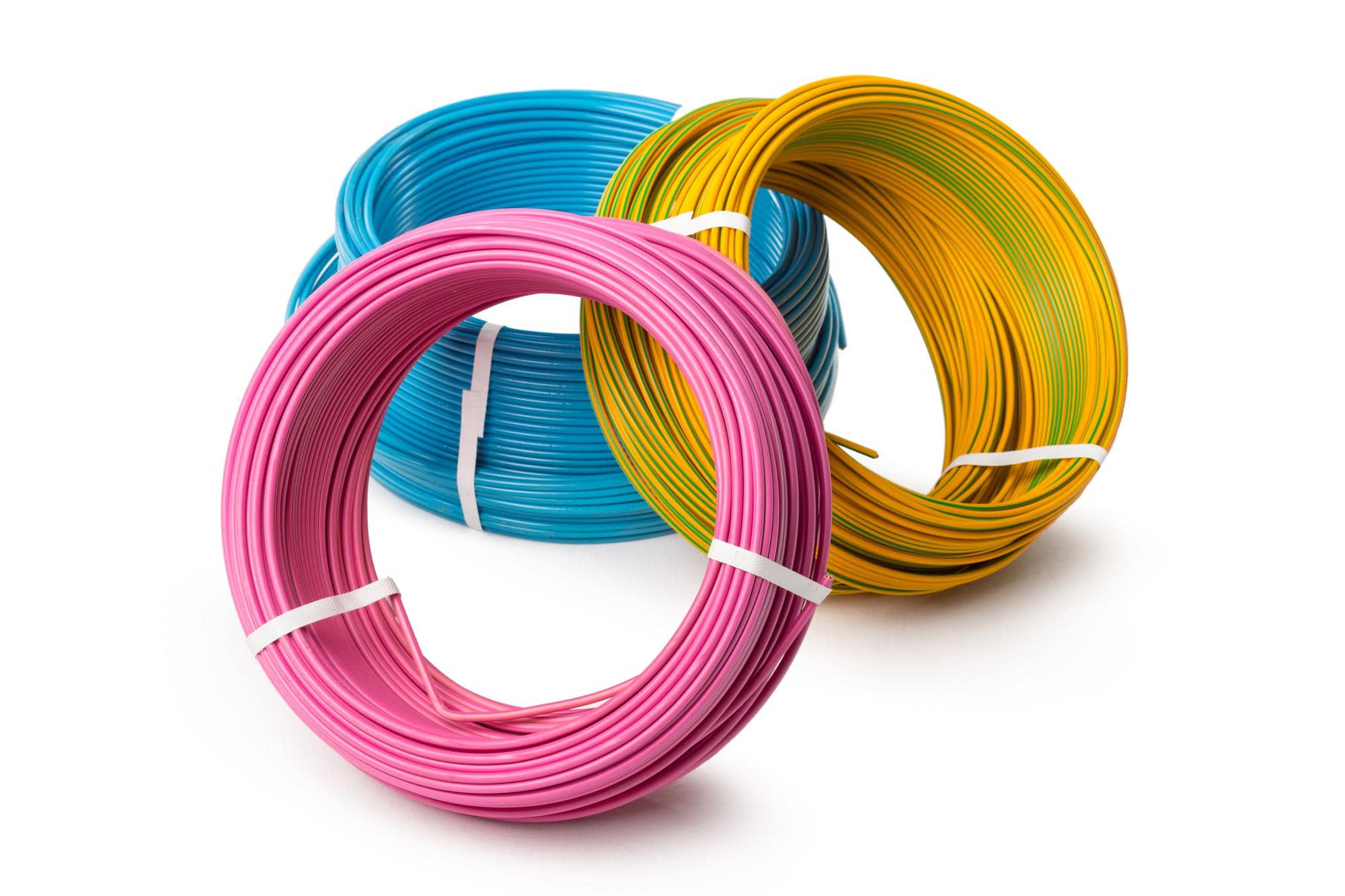Understanding the Basics: A Guide to 6 Different Types of Electrical Wire

When it comes to electrical works, whether it’s a simple home renovation project or a major commercial installation, having a solid understanding of electrical wire types is crucial. Choosing the right wire ensures not only efficient power delivery but also safety for you, your property, and everyone around. In this comprehensive guide, we will explore the fundamentals of electrical wire and shed light on six different types that are commonly used in various applications. Whether you’re a homeowner in London or a professional electrician, this knowledge will empower you to make informed decisions and ensure the success of your electrical projects.
I. Understanding Electrical Wire Basics
An electrical wire, also known as an electrical cable, is a flexible conductor used for transmitting electric power or signals. It consists of one or more conductive metal cores surrounded by an insulating material. The primary purpose of electrical wire is to carry electrical current from a power source to various devices, fixtures, or appliances, enabling them to function correctly.
Key Components of Electrical Wire
- Conductor: The conductor is the central core of the wire responsible for carrying the electric current. It is usually made of copper or aluminum due to its high conductivity properties. Copper is the most common choice for residential and commercial wiring due to its superior conductivity.
- Insulation: The insulation layer surrounds the conductor, providing electrical insulation and protecting against contact with other conductors or surfaces. Common insulation materials include PVC (Polyvinyl Chloride), XLPE (Cross-linked Polyethylene), and THHN (Thermoplastic High Heat-resistant Nylon).
- Jacket (in some cases): In certain types of electrical wire, especially those used in outdoor or harsh environments, a protective jacket is added over the insulation layer. This jacket offers additional protection against moisture, abrasion, chemicals, or sunlight exposure.
Voltage Ratings
Electrical wire is designed to handle specific voltage levels safely. Voltage ratings indicate the maximum voltage the wire can withstand without insulation breakdown. Common voltage ratings for residential and commercial applications include 600V and 1000V.
Gauge Sizes
Wire gauge refers to the diameter of the wire. Smaller gauge numbers represent thicker wires. The gauge size determines the wire’s ampacity, which is the maximum amount of current the wire can safely carry without overheating. Standard gauge sizes for electrical wire range from 18 AWG (American Wire Gauge) to 4/0 AWG, with smaller gauges suitable for lower current applications and larger gauges for higher current demands.
Color Coding
Electrical wire often comes in different colors, serving as a visual indicator of its purpose and function. Common color codes include black for hot/live wires, white or gray for neutral wires, and green or bare copper for ground wires. However, color codes may vary depending on local regulations and specific applications.
Understanding the basics of electrical wire is essential before delving into the different types available. By familiarizing yourself with the components, voltage ratings, gauge sizes, and color coding of electrical wire, you’ll be better equipped to choose the appropriate wire for your specific electrical works.
II. Common Types of Electrical Wire
1.Romex® Cable
Romex® cable is a brand name for a type of Non-Metallic Sheathed Cable (NM cable) commonly used in residential electrical wiring. It consists of two or more insulated conductors, typically color-coded for identification and a non-metallic sheath that encases the conductors.
Typical Uses and Installations:
Romex® cable is widely used in residential settings for various electrical applications. It is commonly employed for powering outlets, switches, lighting fixtures, and household appliances. It is suitable for both new construction and renovation projects.
Pros and Cons:
Romex® cable offers several advantages that make it popular among homeowners and electricians. These include:
– Easy Installation: Romex® cable is relatively easy to work with and install due to its flexible nature and clear markings on the sheath.
– Cost-Effective: It is an affordable option compared to other types of electrical wire.
– Availability: Romex® cable is widely available in hardware stores and electrical supply outlets.
Cons:
– Indoor Use Only: Romex® cable is intended for indoor use and should not be used in outdoor or exposed applications where it may be subjected to moisture or physical damage.
– Limited Temperature Range: Romex® cable has temperature limitations, and it should not be used in areas with high heat or extreme temperature fluctuations.
– Single Voltage Rating: Romex® cable typically has a single voltage rating of 600V, which is sufficient for most residential applications but may not be suitable for commercial or industrial installations with higher voltage requirements.
Overall, Romex® cable is a reliable and widely used option for residential electrical wiring projects. It offers convenience, affordability, and ease of installation. However, it is important to adhere to safety guidelines and local electrical codes when using Romex® cable to ensure a safe and compliant electrical system.
2. Non-Metallic Sheathed Cable (NM)
Non-Metallic Sheathed Cable, commonly known as NM or Romex, is a type of electrical wire that consists of two or more insulated conductors bundled together and surrounded by a non-metallic sheath. The sheath is typically made of PVC (Polyvinyl Chloride) and provides insulation and protection for the conductors within.
Common Applications: NM cable is widely used for general-purpose wiring in residential and commercial buildings. It is commonly employed for outlets, switches, lighting fixtures, and small appliances. NM cable is suitable for both new construction and renovation projects.
Advantages and Considerations: NM cable offers several advantages that contribute to its popularity in electrical installations:
– Ease of Installation: NM cable is relatively easy to work with due to its flexibility and the clear markings on its sheath, which indicate the type and size of the conductors within.
– Cost-Effectiveness: NM cable is an affordable option compared to some other types of electrical wire, making it budget-friendly for a wide range of projects.
– Availability: NM cable is readily available from electrical supply stores, making it convenient for residential and commercial electrical works in London or other areas.
However, there are a few considerations when using NM cable:
– Indoor Use Only: NM cable is designed for indoor use and should not be used in outdoor or exposed applications where it may be exposed to moisture or physical damage.
– Temperature Limitations: NM cable has temperature limitations and should not be used in areas with high heat or extreme temperature fluctuations.
– Single Voltage Rating: NM cable typically has a single voltage rating of 600V, which is suitable for most residential and commercial applications. However, it may not be suitable for installations with higher voltage requirements.
When choosing NM cable, consider the specific needs of your project, including the number of conductors required, the anticipated electrical load, and compliance with local electrical codes and regulations. Following proper installation practices and adhering to safety guidelines will ensure the effective and safe use of NM cable in your electrical works.
3. Armored Cable (AC)
Armored Cable, also known as AC cable or BX cable, is a type of electrical wire that combines the benefits of a metallic armor layer with insulated conductors. It consists of insulated conductors, typically made of copper or aluminium, encased in flexible metal armor, usually made of steel.
Suitable Applications and Environments:
Armored cable is commonly used in commercial, industrial, and residential settings where additional protection against physical damage, including impact, crushing, or puncturing, is required. It is suitable for both indoor and outdoor installations, making it versatile in various environments.
Benefits:
- Enhanced Protection: The metal armor surrounding the conductors provides excellent protection against mechanical damage, such as accidental impact, crushing, or rodent interference.
- Grounding Capability: The metal armor of the cable serves as a grounding conductor, eliminating the need for a separate ground wire in many installations.
- Flexibility: The flexible nature of the armored cable allows for easier installation, especially in areas where bending or maneuvering is required.
Drawbacks:
- Rigidness: Compared to other types of electrical wire, armored cable can be relatively rigid, making it less suitable for applications that require tight bends or complex routing.
- Installation Challenges: The metal armor may require specialized tools and techniques for cutting, stripping, and terminating the cable.
- Cost: Armored cable is generally more expensive than non-armored cable options due to its added protection and features.
Overall, the armored cable provides an excellent balance between protection and flexibility. It is commonly used in areas where additional durability and resistance to physical damage are essential. When considering the use of armored cable, it is important to assess the specific requirements of the installation, local electrical codes, and the environment in which it will be used to ensure proper selection and installation practices.
4. Underground Feeder Cable (UF)
Underground Feeder Cable (UF) is a type of electrical wire specifically designed for direct burial applications without the need for a conduit. It consists of insulated conductors encased in a moisture-resistant and sunlight-resistant outer jacket.
Installation Requirements and Restrictions:
UF cable is primarily used for underground electrical wirings, such as outdoor lighting, landscape installations, and outdoor electrical connections. It is suitable for direct burial in the ground, eliminating the need for conduit. However, there are specific requirements and restrictions to consider when using UF cable:
- Burial Depth: UF cable must be buried at a sufficient depth to protect it from damage. The specific burial depth requirements may vary based on local electrical codes and regulations.
- Environmental Considerations: UF cable is designed to withstand exposure to moisture, sunlight, and certain chemicals. However, it should not be exposed to extreme temperatures or harsh chemicals that can compromise its integrity.
- Protection: While UF cable is designed for direct burial, it is recommended to provide additional protection, such as using a conduit or PVC piping, in areas where the cable may be exposed to potential physical damage.
Advantages:
- Simplicity of Installation: UF cable eliminates the need for a separate conduit, reducing installation time and complexity.
- Moisture and Sunlight Resistance: The outer jacket of UF cable provides resistance to moisture, sunlight, and certain chemicals, ensuring long-term durability.
- Flexibility: UF cable is relatively flexible, allowing for easier installation and routing around obstacles in the ground.
Considerations:
- Limited Above-Ground Use: UF cable is primarily designed for direct burial applications and should not be used above ground or in exposed locations where it may be susceptible to physical damage.
- Depth Requirements: Local electrical codes dictate the minimum burial depth for UF cable, and it is crucial to adhere to these requirements to ensure safety and compliance.
- Protection and Support: While UF cable offers some protection against physical damage, it is recommended to provide additional protection and support, such as using a conduit or burying it in a trench, to safeguard the cable from accidental impacts or digging activities.
When considering UF cable for underground electrical installations, it is crucial to assess the specific requirements of the project, including burial depth, environmental conditions, and any local regulations. Proper installation practices and compliance with electrical codes are essential for a safe and reliable underground electrical system.
5. Conduit Wiring
Conduit wiring involves the use of metal or non-metallic conduits to protect and route electrical wires. A conduit is a hollow tube that serves as a protective sleeve for the wires, shielding them from physical damage and providing a clean and organized installation. Conduit systems consist of various types of conduits, fittings, and connectors that allow for the secure routing and protection of electrical wires.
Different Types of Conduits: There are several types of conduits commonly used in conduit wiring:
– Rigid Metal Conduit (RMC): RMC is a thick-walled metal conduit, typically made of steel, that provides excellent protection against physical damage. It is commonly used in commercial and industrial applications where durability and robustness are essential.
– Intermediate Metal Conduit (IMC): IMC is a lighter-weight metal conduit, also made of steel, that offers good protection while being more flexible than RMC. It is suitable for both indoor and outdoor applications and is commonly used in commercial and industrial settings.
– Electrical Metallic Tubing (EMT): EMT is a thin-walled metal conduit, usually made of steel or aluminum, that provides moderate protection and flexibility. It is commonly used in residential and commercial applications and is often preferred for its ease of installation and cost-effectiveness.
– PVC Conduit: PVC conduit is a non-metallic conduit made of rigid polyvinyl chloride (PVC). It is lightweight, corrosion-resistant, and easy to work with. PVC conduit is commonly used in residential and commercial applications where non-metallic properties are desired, such as in damp or corrosive environments.
Applications and Benefits: Conduit wiring offers several advantages in electrical installations:
– Protection: Conduits provide physical protection to electrical wires, safeguarding them against damage from impact, moisture, chemicals, and environmental elements.
– Flexibility: Conduit systems allow for flexibility in routing wires, accommodating changes or additions to the electrical system more easily.
– Compliance with Codes: Conduit wiring helps ensure compliance with local electrical codes and regulations, which often require the use of conduits in certain applications.
– Grounding: Metal conduits, when properly installed and connected, can serve as a grounding conductor, enhancing electrical safety.
Conduit wiring is suitable for a wide range of applications, including commercial, industrial, and residential settings. The choice of conduit type depends on factors such as the level of protection required, installation environment, and project budget. Make sure you follow proper installation techniques, including correct sizing, securing, and grounding of conduits, to ensure a safe and effective conduit wiring system.
6. Low Voltage Wiring
Low-voltage wiring refers to the use of specialized wires for low-voltage applications, typically below 50 volts. Unlike standard electrical wiring that carries higher voltages, low-voltage wiring is primarily used for transmitting data, and signals, or powering low-power devices.
Examples of Low Voltage Applications: Low voltage wiring finds application in various settings and devices, including:
– Home Automation Systems: Low voltage wiring is commonly used in home automation systems to control lighting, thermostats, security systems, and audio/video equipment.
– Communication and Data Networks: Low voltage wiring is essential for networking infrastructure, including Ethernet cables, coaxial cables, and fibre optic cables used for data transmission.
– Security and Surveillance Systems: Wiring for security cameras, sensors, and alarm systems typically fall under low voltage applications.
– Doorbell Systems: Low voltage wiring is used to connect doorbells, intercom systems, and access control devices.
– Landscape Lighting: Low voltage wiring is commonly employed for outdoor lighting in gardens, pathways, or decorative installations.
Advantages:
– Safety: Low voltage systems are considered safer than higher voltage systems since they carry lower amounts of electrical current, reducing the risk of electrical shock.
– Ease of Installation: Low voltage wiring is generally easier to install compared to higher voltage electrical wiring, as it may not require conduit and is more flexible.
– Versatility: Low voltage wiring allows for the integration of various devices and technologies, enabling the creation of interconnected systems.
– Energy Efficiency: Low voltage systems tend to be more energy-efficient, as they consume less power compared to higher voltage systems.
Disadvantages:
– Voltage Drop: Due to the lower voltage levels, low voltage systems may experience voltage drop over long distances or when powering multiple devices. Proper calculations and considerations should be made to mitigate voltage drop issues.
– Signal Integrity: In applications involving data transmission, maintaining signal integrity is crucial. Proper cable quality, shielding, and termination techniques must be employed to minimize signal loss or interference.
– Compatibility: Low voltage systems may require specific devices and equipment designed for low voltage operation. It is important to ensure compatibility between components and follow manufacturer guidelines.
Low-voltage wiring plays a vital role in various technological systems and applications. Whether it’s for home automation, communication networks, security systems, or landscape lighting, understanding the specific requirements and best practices for low-voltage wiring is essential for achieving reliable and efficient operation.
Conclusion:
Choosing the right electrical wire is crucial for successful electrical works in London or any location. By understanding the characteristics of the six types covered; Non-Metallic Sheathed Cable (NM), Romex® Cable, Armored Cable (AC), Underground Feeder Cable (UF), Conduit Wiring, and Low Voltage Wiring, you can make informed decisions for your projects.
Consult professionals and follow local codes for a safe and compliant installation. Prioritize safety, efficiency, and adherence to budget. Make informed decisions and embark on your electrical works with confidence, knowing you have chosen the right wire for your specific needs.
Let us know how our electrical services be helpful with your unique needs
Related Posts

Your Trusty Local Emergency Electrician in London

How Your Local Electric Company Fuels Community Growth
About Us
Lorem ipsum dolor sit amet, consectetur adipiscing elit. Phasellus pharetra pretium leo, sed lacinia nulla. Quisque iaculis, lectus sed eleifend vehicula, mi elit facilisis purus, vitae ornare magna elit non quam.
